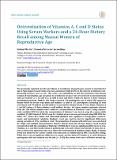| dc.description.abstract | We previously reported that the prevalence of oral thrush among Maasai women of reproductive age in Ngorongoro Conservation Area was abnormally high (32%) in the absence of immune-com- promising diseases such as HIV. This study was undertaken to test the hypothesis that Maasai women of reproductive age are prone to oral thrush because they are deficient in micronutrients such as Vitamins A, C, D, and B12, as well as iron and folate which are known to have immune modulating functions. Method: The study recruited 210 participants out of which 180 agreed to donate blood for serum separation and analyses. A total of 107 participants (including 28 with oral thrush and 79 without oral thrush) were assessed for dietary intake of iron, folate, Vitamins A, C, and B12 using a 24 hours dietary recall method. Further, 40 serum samples randomly selected from the 180 serum samples were tested for concentrations of Vitamins A and C using commercially available HPLC kit while the concentration of Vitamin D was tested using the commercially available 25-OH Vitamin D ELISA Assay kit. Statistical analysis was performed using IBM SPSS Statistics 20™, where descriptive and inferential statistics were applied to demographic, socioeconomic and biochemical variables. Student’s t-test was used to test for significant differences among variables at 95% confidence level. The proportion of women with deficiency was calculated for single and multiple micronutrients. Results: Results from the 24-hour dietary recall method revealed that with the exception of folate (p = 0.000), there were no significant differences in iron, Vitamins A, C, and B12 intake between participants with and without oral thrush. Of note, the in- take of these four micronutrients was below the Recommended Nutrient Intake (RNI). A similar trend was observed for serum vitamin concentrations as established by HPLC and ELISA testing. While there was no significant difference in serum concentration of Vitamins A, C, and D between participants with and without oral thrush (p > 0.05), the serum levels were all below normal signifying deficiency of micronutrients in the sample. Conclusion: Overall, this study revealed micronutrient deficiency in the women of reproductive age in the Ngorongoro Conservation Area, which may contribute to the previously reported high levels of oral thrush. Recommendations: Nutrition education directed to this community on the importance of eating micronutrient rich foods such as fruits and vegetables is highly recommended. | en_US |

